Part 2: What’s the Difference Between Dog Rescue Groups & Breeders; Westminster & Puppy Mills? Less Than You Think. A Giveaway!
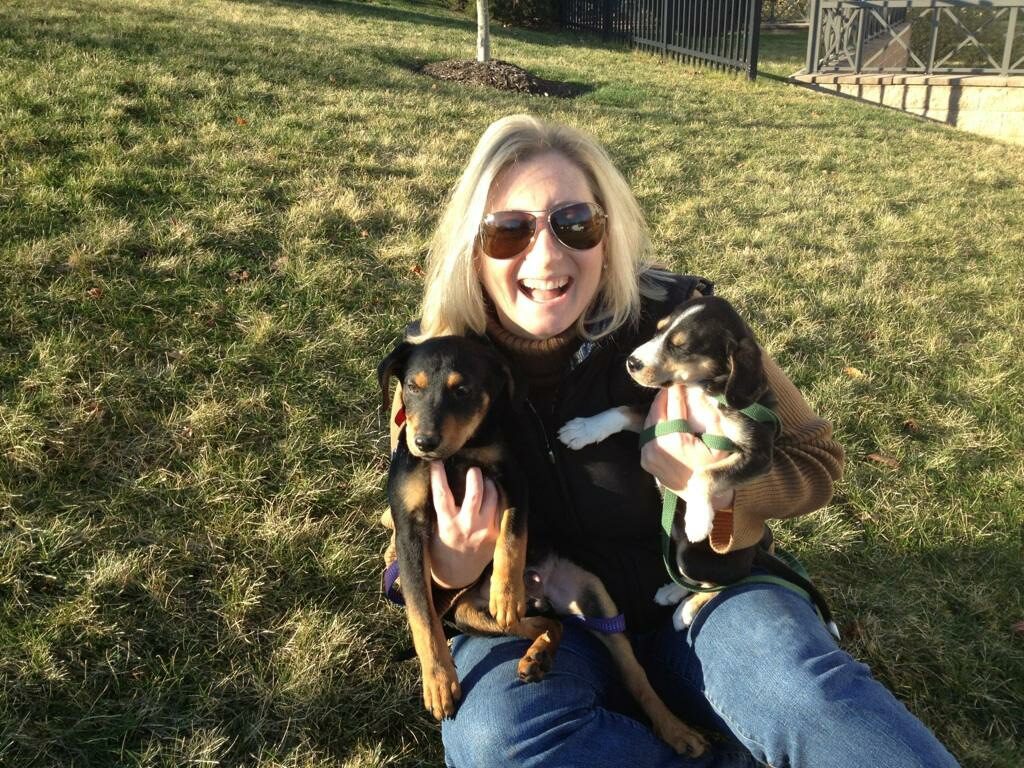
Kim with Cooper & Petey
Welcome to Part 2 of my story about the book, The Dog Merchants: Inside the Big Business of Breeders, Pet Stores, and Rescuers, the critically-acclaimed must-read if you love dogs and intend on adding a dog to your family. The Washington Post called it “fascinating…” and gave it five stars. It’s a Chicago Tribune Top Pick. It was the most interesting and compelling dog book I’ve read this year. Buy it, or throw your hat into the ring in my giveaway, starting today!
Yesterday, in Part 1, we discovered who really frequents the dog auctions, including dog rescue groups, how much income a dog purchased at auction could potentially generate for a breeder over 5 years, and how an iconic industry competition like Westminster plays a big part in the dog selling business.
In Part 2, we’re going to discover the different types of breeders, learn what’s behind the heavily-guarded closed doors of one of the biggest dog distributors and how we can create real change to make things better for all dogs in this system. So, grab your favorite beverage, get comfortable and let’s get to it!
Breeders: They’re Not All Alike
Large, commercial breeders, small-scale ones, backyard breeders – they all co-exist in this business of selling dogs, but it’s us, the consumer, who is really in the driver’s seat. Let’s break it down:
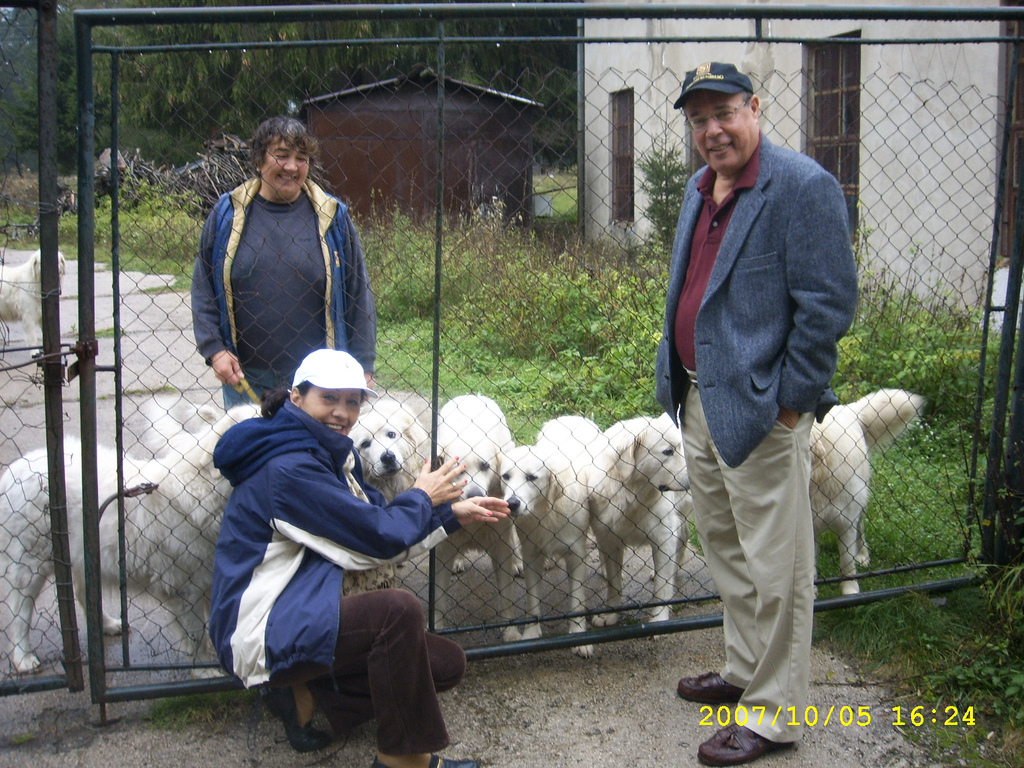
The hobby breeders are small-scale, who usually turn out one or two litters of puppies a year. According to Kavin, they often trying to better their preferred breed, and breed for both pets and the show ring.
Backyard breeders are also small scale. They may start out as dog owners who don’t spay and neuter and find, after a time, that it all just gets out of hand. They may have the best of intentions or they may not be good people at all. And, often but not always, these are the breeders we hear the horror stories about.
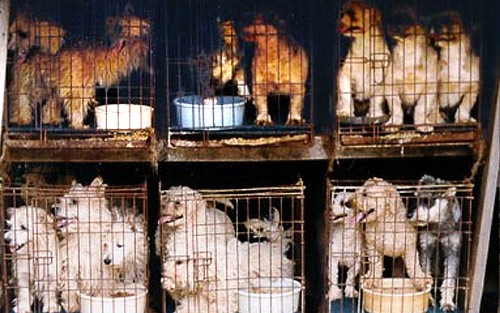
Colleen Nicholson of Kelview Dobermans in central Pennsylvania, cares a lot about Dobermans. She got into breeding after buying her first Dobie from a backyard breeder, “…a man she later realized was the epitome of everything that is wrong with the small-breeder end of the dog industry,” as Kavin writes. Colleen advises in the book, “It’s important for buyers to ask questions…Then ask more questions. And more still. If any breeder, even one who seems to have impeccable references and is charging thousands of dollars, won’t answer every question or make eye contact, move on…’Never,’ she says, pausing for emphasis, ‘never ever make assumptions.'”
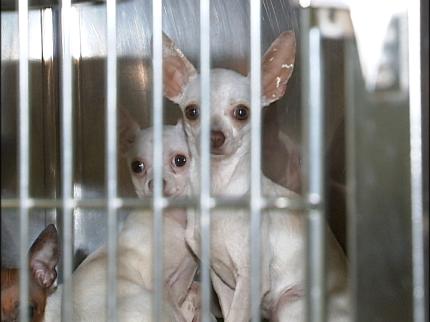
AKC dog show judge and Chihuahua breeder, Margaret Ann Hamilton, and trusted vet tech and Poodle breeder, Laura King, are two cases in point. When their homes were raided through tip offs, dogs were found living in deplorable conditions with multiples in single cages, others running around loose on feces-caked and urine-soaked floors. In Hamilton’s case, authorities found “…about a hundred dogs living in feces-covered stacked crates, walking in neurotic circles from constant confinement, and desperately in need of medical care, some so badly malnourished their jawbones were decomposed or gone.” Yet, both women had outstanding references in the outside world, conducting their breeding businesses behind closed doors. These are usually one-person operations, but add the larger small-scale breeders or breeder networks around the world to the mix, the lack of sufficient laws to protect the dogs and customers shopping more and more online or wanting that particular breed or dog so badly they don’t ask questions, and you have the continued proliferation of the worst offenders. “‘As long as there is demand, there will always be suppliers,'” says Julie Sanders, the United Kingdom manager for Four Paws, an international animal charity with offices throughout Europe, as well as in South Africa and the United States. “‘If there is money to be made, people will do it.'”
Kavin also highlights responsible small-scale breeders like Stefano Paolantoni, owner of Dell’Alberico Kennel in Italy’s Chianti region, and Japan’s Yoshinori Omura from a kennel called Smash. He says, “‘A responsible breeder is not breeding according to the requests of the market. He is breeding to improve the breed and to keep it at a high level.'” Kim reports that Paolantoni may have eighty or so dogs in his care, but he treats them like his pets, they rotate sleeping in his bed and he doesn’t use them up and then discard them. She goes on to say, “And while eighty dogs may seem, to some people, like an awfully high number, it is actually a common sight on puppy farms throughout the world. In those places, far more than twenty litters of puppies a year are being produced – and those dogs don’t always get to live until they’re old. Most of them have never even imagined, let alone been given a chance, to sleep in a human being’s bed, and the only thing they have to do with dog shows is filling the demand created by them.”
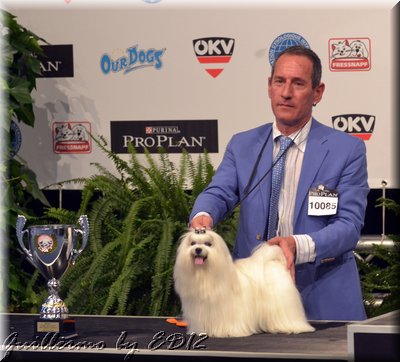
Stefano Paolantoni & his champion Maltese, Cinecitta Sasha Baron Cohen.
One of the biggest problems with small-scale breeders is the lack of regulation. In America, breeders aren’t inspected by federal agents if they have fewer than four breeding females. “Despite the huge scope of the breeding business worldwide, many of the people dealing in purebred puppies are still tiny, independent producers,” Kim explained. And, in more cases than we even know, their dogs aren’t living in the best of conditions.
But, that’s not true at Missouri’s Monark Puppies, one of the big commercial breeders, large enough to be inspected by the federal government. Started and owned by Dave and Judy Miller, they raise everything from beef cattle and quarter horses, to dogs and grandchildren, as Dave Miller describes. Their Newfoundlands, Beagles, Shiba Inus, Corgis and Puggles are well cared for, living in open-topped, large pens with cedar-chip beds and insulated water stations, and newborn puppies and their mothers live in temperature-controlled buildings with heated beds. Dave and Judy resent theirs being called a puppy mill. Dave said he would defy anyone to raise a puppy in their home that’s as well cared for as theirs. He says it’s insanity to equate every pet store dog with a puppy mill dog. They sell to brokers and to pet stores. They are licensed and inspected at the federal, state and local levels. They lament the way the region’s less responsible commercial breeders treat their dogs, breeding them into old age and then killing them. In a state that houses 20% of the worst puppy mills in America, Monark stands out as a responsible large commercial breeder. “‘If we had a complete sellout tomorrow and if I were so broke that I couldn’t buy dog food, we’d find a way to keep the ones who needed taking care of,’ he said, raising his eyebrows and looking over his shoulder to see if his wife happened to be watching him through the house windows. ‘Judy wouldn’t stand for her dogs being mistreated.'” The Dog Merchants
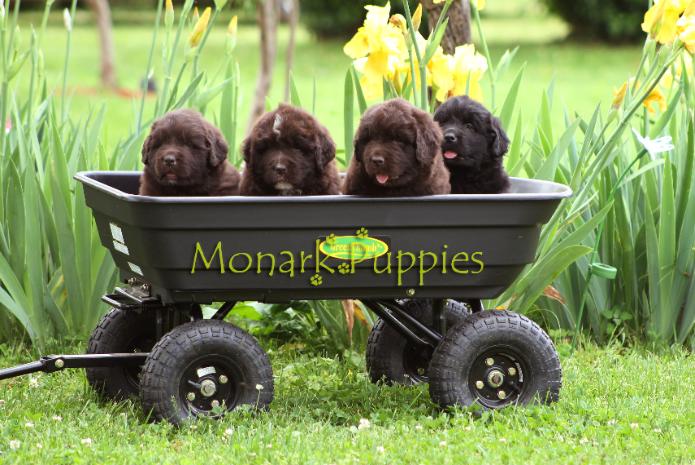
The Mega Middleman (the Distributor)
Anyway you look at it, The Hunte Corporation is the giant amongst dog distributors. According to Kavin, they are likely the biggest legal distributor of puppies to pet stores across America. About 45,000 dogs pass through its $10 million, 200,000 square foot facility in Goodman, Missouri. They are very secretive, allowing only carefully pre-screened visitors beyond the thick, heavy front door. In a way, you can understand, given the number of times animal activists have targeted them, even following the company’s trucks into a field and locking their drivers inside with the puppies.
But, in late August, 2014, Kim was given access and because of that, so have we. It seems that Hunte is a highly systemized, well-run machine. Kim reported a brightly lit space, a white hallway so long that it seemed almost to disappear into the distance, workers wearing different-colored scrubs to indicate their job titles, a photography room, grooming room, surgery suite and more. The kennel section houses thirteen numbered doors. Inside each are rows and kennel-style cages like the ones used in vet’s offices and animal shelters. All meet USDA regulations, depending on a puppy’s size. Each room is climate controlled and separately ventilated to prevent the spread of airborne diseases. There’s no unpleasant smell. The puppies looked calm, when she walked by, or were jumping up and down, vying for attention like puppies do.
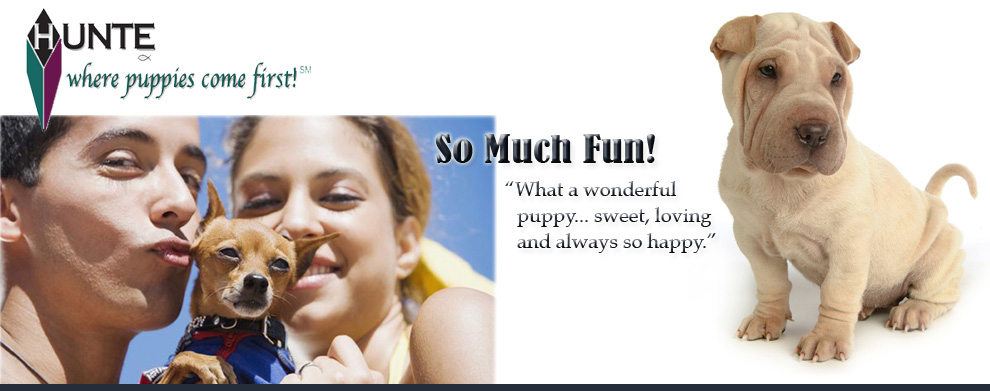
The marketing of Hunte.
Sick or stressed puppies are removed from the population into the “sick puppy room,” for upgraded care with equipment, additional space for moving around, whatever the puppy needs to get better. They are vetted, vaccinated, bathed, groomed, watched for signs of behavioral issues. As Kim writes, “Stress, after all, often leads to sickness, and Hunte claims that pretty much everything it does is based on maintaining the puppies’ health. The motive is of course not entirely altruistic; a solid cash flow would prod even the worst company to treat the dogs decently. Sick puppies at the end of the line don’t sell, and puppies who don’t sell are just plain bad for business.”
Hunte is vilified, sometimes justly, for its assembly line approach to dealing with warm and cuddly little beings. Over the years, it has been slapped with several lawsuits and USDA violations. In 2009, the Humane Society of the United States filed a class-action suit against it and the pet store chain, Petland, which receives the majority of Hunte’s puppies, claiming racketeering and additional complaints of sick puppies from thirty-one people who bought dogs from a Petland store. A judge dismissed Hunte from the proceedings in 2010 with no findings of guilt. Hmm…
How can we create change for dogs?
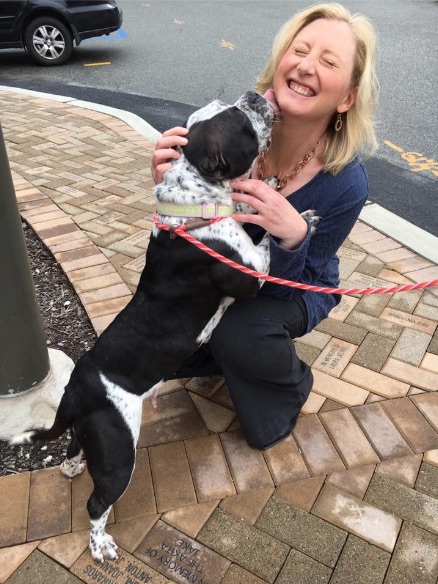
Kim with Betsy, adopted from Coming Home Rescue at her book signing.
So, here we are, at the end of a post so long, it needed two parts. Why? I think this is such an important topic, I am doing my best to capture the breadth of what Kim Kavin covers in The Dog Merchants. I could write even more to get it all in, but hopefully, you have a good amount of information to know whether you want to educate yourself more about the big business of selling dogs. I’d recommend it, because armed with this information, you are equipped to ask the right questions of breeder, store or rescue and to make an informed choice.
Why isn’t there a central place you can go to read reviews on breeders, rescues, stores? Kim Kavin asked the same thing. So, she’s created a one-stop Angie’s List for those looking to add a dog to the family and she needs us to contribute to make it work.
Go to The Dog Merchants site and rate your own experience in buying or rescuing your dog. If enough people input theirs, this ambitious and important database will serve its purpose: to give us a place to take control and influence lifting the good places up and eradicating the awful places, thereby making the dog business a better place for the dogs at its core.
“When it comes to dogs, the endgame is not so clear,” Kavin states. “What each of us does when it comes time to buy a dog really can make a difference. So many of the worst offenders are such small players in this big global web that if conscious consumers can learn how to spot them, we can end them – by voting with our wallets to buy mutts and purebreds alike from people who treat all dogs well.”
We have that power! Loving dogs and knowing that…why wouldn’t you want to use it?
The Giveaway!

One Bark & Swagger follower will be able to win an autographed copy of this wonderful book. To enter, just sign up for our email list, thereby joining the Bark & Swagger Family. You must be 18 years or older and live in the U.S.
The giveaway begins Sunday, June 19th at 7pm EST and ends Sunday, June 26th at 11:59pm EST.
To get extra points:
- Go to The Dog Merchants site and enter and rate your breeder, rescue, store.
- Like Bark & Swagger on Facebook
- Like The Dog Merchants on Facebook
- Follow Bark & Swagger on Instagram
- Follow The Dog Merchants on Twitter
Good luck!
Tell me your experience when getting your dog; was it a good or bad one? Would you recommend that place to others?
If you liked this story, you might also like my story on the No Kill Movement.




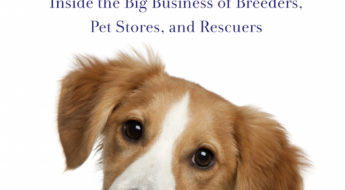
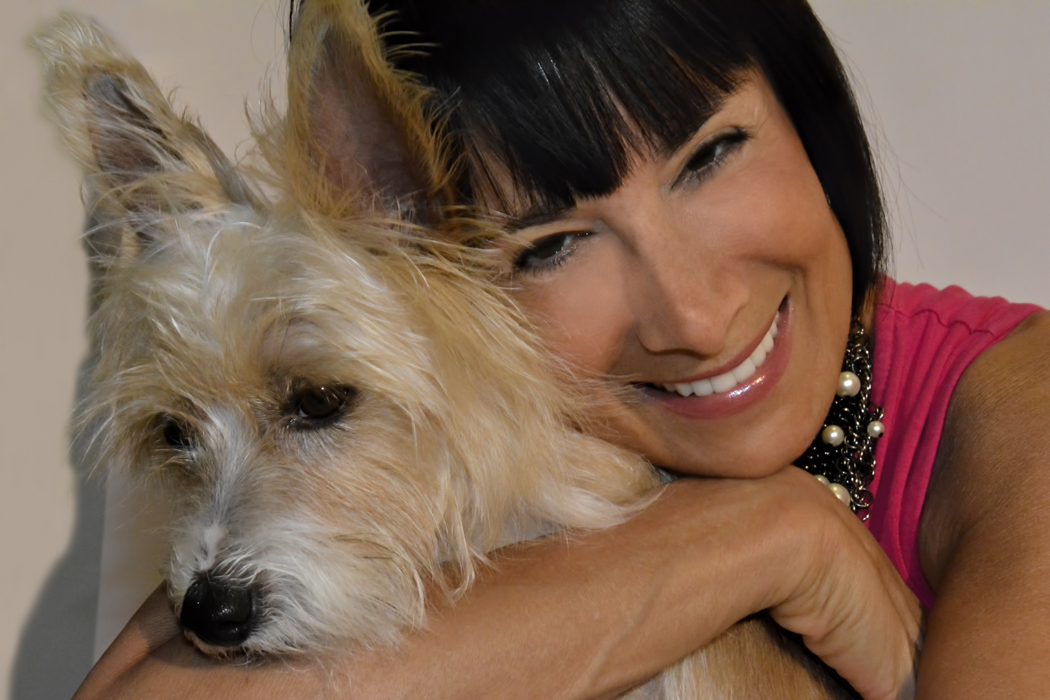


I found it interesting that Kim Kavin was able to profile a large scale facility, with the owners ironically named the “Millers”, where the dogs are well cared for, when it’s our assumption that all large scale breeders are dirty “puppy mills” where dogs are breed and neglected. The problem is that taking good care of the dogs is left to the integrity of the people running the mills and too many of them cut corners on the care/vetting and breed the dogs every cycle for maximum profit. “USDA regulated” doesn’t mean that the dogs are cared for because the USDA doesn’t have the resources to inspect and enforce corrections of violations, and sadly, the Animal Welfare Act, that is supposed to protect the dogs, allows them to be kept in substandard conditions. We really need legislation that is for all of the dogs, requiring them to have good care, whether it’s a breeder or a rescue/shelter, and we need strict laws against cruelty.
On another note, I was impressed with the chapter about the Hunte Corporation. It’s interesting that the reason it was started was to provide healthier puppies to the pet stores and the standards and care sound very impressive (other than it would be MUCH better for all puppies to go from the breeders home to the new owners home, never stopping at a broker or a pet store).
I know! It was heartening to learn there are big commercial breeders who seem to really care about the dogs. I loved how Dave Miller looks to see if his wife Judy is looking out the window as he’s talking to Kim about how she’d never stand for her puppies to be mistreated. I also found his quote about how crazy it was to equate every pet store dog with a puppy mill dog, as theirs are sold in pet stores. I always thought and was told that every puppy in every pet store came from a puppy mill, where their parents lived in horrible conditions. Kim’s book definitely blurred the lines for me some. I still would want to rescue instead of purchase from a breeder, but I’m not so sure every breeder is the bad guy anymore. And I do see how breeders and rescues coming together with one voice to make things better for the dogs makes sense and is important. And, you’re so right; we do need much better, stronger laws that apply to anyone breeding dogs to sell, period. Hopefully, that change is slowly coming.
Thank you for informing the dog owners on where your purebred dog could be coming from. If you research the breeder carefully, your choice will be a good one. Don’t buy from pet shops ever, go to the breeders home to pick a puppy. Always plan ahead for adding a puppy or older dog to your home.
Thank you for your comment, Julie! You’re so right. Reading The Dog Merchants was such an eye opener for me. As Coyote Windsong said in her comment, its more about the responsible vs the irresponsible, whether you’re talking about breeders or rescues, and as consumers, realizing we have the power to put the irresponsible ones out of business by educating ourselves and using our wallets to make that statement. Thanks again for commenting, Julie!